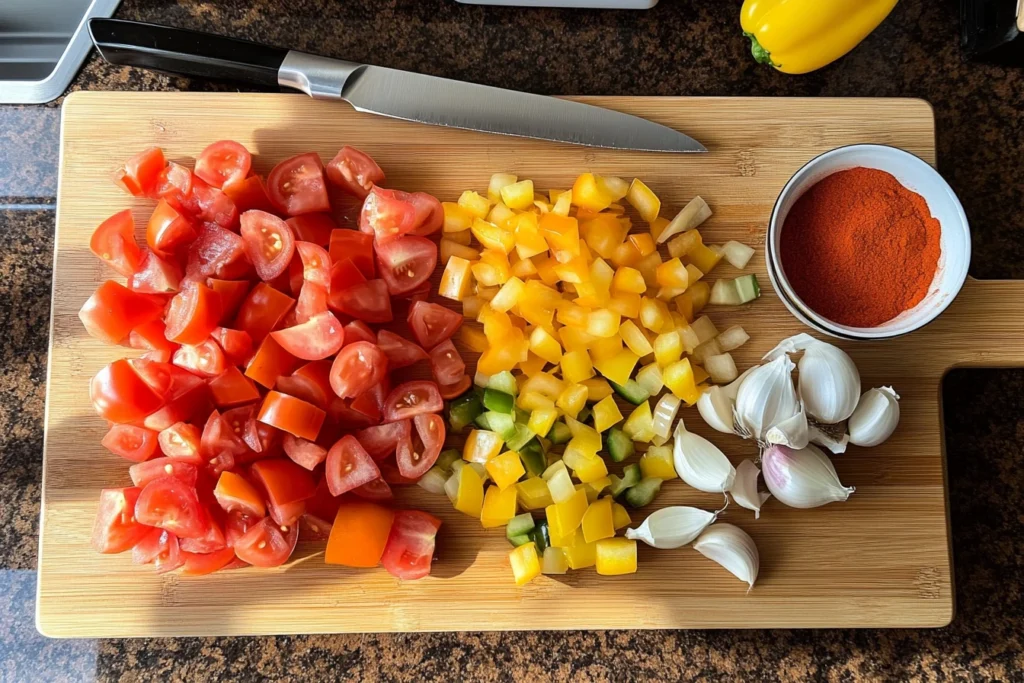Table of Contents
Shakshuka has gained global popularity for its rich, savory flavors and its reputation as a wholesome, nutritious meal. But if you’re counting calories or trying to make healthier food choices, you might be asking, how many calories are in shakshuka? The truth is, the calorie count can vary depending on the ingredients and preparation method.
What is Shakshuka?
Ingredients Overview
Shakshuka is a flavorful one-pan dish that features poached eggs in a spiced tomato-based sauce. While the traditional version includes basic ingredients like tomatoes, onions, and garlic, shakshuka is a highly versatile recipe. Here’s a closer look at the common components and their calorie contributions:
- Eggs: A key ingredient, each large egg contains about 70 calories.
- Tomatoes: The base of the dish, fresh or canned tomatoes are low in calories, adding only 30–40 calories per cup.
- Olive Oil: Often used for sautéing, olive oil adds richness but also contributes about 120 calories per tablespoon.
- Vegetables: Bell peppers, onions, and garlic bring flavor and nutrients with minimal calories.
- Spices: Cumin, paprika, and chili flakes are calorie-free but essential for shakshuka’s distinctive taste.

Variations That Impact Calories
While the basic version of shakshuka is relatively light, different variations can affect its calorie content:
- Adding feta cheese or cream increases richness but adds 75–150 extra calories per serving.
- Including sausages or ground meat for protein can add significant calories, depending on the portion size.
- Opting for a plant-based shakshuka with chickpeas or tofu slightly increases the carbohydrate count while keeping the dish healthy.
Calories in a Standard Shakshuka Serving
Nutritional Breakdown
Now that we’ve covered the basics, let’s take a closer look at the calorie content of a standard serving of shakshuka. Typically, a single serving consists of one large egg cooked in about a cup of tomato-based sauce. While the exact calorie count depends on the recipe, here’s an average breakdown:
| Nutrient | Amount |
|---|---|
| Calories | ~200 kcal |
| Protein | ~10g |
| Total Fat | ~10g |
| Carbohydrates | ~15g |
| Fiber | ~3g |
At its core, shakshuka is a well-balanced meal. The eggs provide high-quality protein and healthy fats, while the tomato sauce offers vitamins, antioxidants, and a hint of natural sweetness. This combination makes shakshuka both satisfying and nutritious.
Factors Influencing Calorie Count
However, the calorie content of shakshuka isn’t set in stone. Several factors can influence the final tally, including:
- Number of Eggs: Each additional egg adds approximately 70 calories. For example, a two-egg portion increases the total calories to around 270 kcal.
- Cooking Oil: Using extra olive oil can quickly add calories. A tablespoon contains about 120 kcal, so measuring carefully is essential.
- Extras: Adding cheese or meat can elevate the flavor but also significantly increase the calorie count. For instance, a serving with feta cheese and sausage could easily reach 400–500 kcal.
- Portion Size: A standard serving is typically one egg with sauce, but larger portions naturally increase the calorie count.
Calorie Comparisons
To put things into perspective, let’s compare shakshuka to other popular breakfast options:
- A traditional breakfast sandwich can contain anywhere from 300–500 calories, depending on the bread and fillings.
- A bowl of granola with milk averages around 250–350 calories but often lacks the protein content of shakshuka.
- A smoothie bowl can range from 200–400 calories, with most of its calories coming from sugars and carbs.
As you can see, shakshuka offers a more balanced profile, with fewer empty calories and a healthier balance of macronutrients.
Low-Calorie Shakshuka Options
Ingredient Swaps for Healthier Versions
If you’re aiming to lower the calorie count in shakshuka, the good news is that there are plenty of simple ingredient swaps that can help. For instance, instead of using traditional olive oil for sautéing, you can opt for a non-stick cooking spray. This small change reduces the calories by about 100–120 per tablespoon without sacrificing the dish’s flavor.
Additionally, you might consider replacing whole eggs with egg whites. While whole eggs bring richness and healthy fats, egg whites are incredibly low in calories—only about 17 per large egg white—making them a perfect choice for those looking to cut back on fat.
Moreover, you can skip the cheese or use a smaller portion of it. Although feta cheese adds a delicious creaminess, just an ounce contains approximately 75 calories. Substituting it with fresh herbs like parsley or cilantro provides flavor without adding unnecessary calories.
Finally, if you want to bulk up the dish without adding calories, consider including more low-calorie vegetables. For example, zucchini, spinach, or mushrooms can add volume and nutrients while keeping the calorie count low.
Portion Control Tips
Of course, tweaking the ingredients isn’t the only way to enjoy shakshuka while keeping your calorie intake in check. Paying attention to portion sizes can make a huge difference too. For starters, try serving shakshuka on smaller plates. This simple trick makes your portion feel larger and can help prevent overeating.
Additionally, you can serve shakshuka alongside healthier sides to balance the meal. Instead of pairing it with bread or pita, consider adding a crisp green salad. Not only does this reduce the overall calorie load, but it also provides extra fiber to keep you feeling full longer.
Another tip is to stick to one egg per serving if you’re calorie-conscious. While it might be tempting to add more eggs, limiting them ensures the dish remains light yet satisfying.
A Quick Low-Calorie Example
Here’s a practical example of a low-calorie shakshuka:
- 1 egg (70 calories)
- 1 cup of tomato sauce (35 calories)
- 1 teaspoon of olive oil (40 calories)
- 1 cup of spinach and zucchini (20 calories)
Total Calories: ~165 kcal
This version is not only light but also loaded with flavor and nutrients. Plus, it still feels like a hearty meal thanks to the generous portion of vegetables.
Is Shakshuka Good for Weight Loss?
Protein and Fiber Benefits
If you’re wondering whether shakshuka can support your weight loss goals, the answer is a resounding yes! First and foremost, shakshuka is naturally rich in protein, thanks to the eggs. Protein is essential for maintaining muscle mass and keeping hunger at bay. Unlike carb-heavy meals that can lead to energy spikes and crashes, the protein in shakshuka helps you feel full and energized for hours.

In addition to protein, shakshuka is packed with fiber from its vegetable-rich base. Fiber not only aids digestion but also helps stabilize blood sugar levels, which is crucial for managing cravings. Moreover, the combination of fiber and protein creates a meal that’s both satisfying and nourishing—a key factor for anyone on a weight loss journey.
Balanced Meal Option
Another reason shakshuka is great for weight loss lies in its balance of macronutrients. With a healthy mix of protein, fats, and carbohydrates, this dish provides all the essentials your body needs without going overboard on calories.
For example, the fats from olive oil and eggs are considered “healthy fats” that support brain function and keep you feeling satiated. Meanwhile, the carbohydrates in the tomato sauce and vegetables are low-glycemic, meaning they provide a slow and steady energy release instead of a quick sugar spike.
Furthermore, shakshuka is versatile enough to fit into different dietary plans. Whether you’re following a low-carb, high-protein, or plant-based diet, there’s a variation of shakshuka that works for you. By making small adjustments—such as reducing the amount of oil or skipping bread—you can tailor the dish to suit your specific goals.
Why Shakshuka Stands Out
It’s worth noting that shakshuka isn’t just good for weight loss—it’s also an enjoyable and sustainable choice. Unlike many “diet foods” that can feel restrictive or bland, shakshuka is bursting with flavor. Its warm spices, vibrant colors, and rich textures make it a meal you’ll look forward to eating, whether you’re on a diet or not.
Moreover, shakshuka’s one-pan preparation makes it incredibly convenient for meal planning. You can easily prepare a large batch, store it in the fridge, and reheat it for quick, healthy meals throughout the week. This convenience means you’re less likely to reach for unhealthy options when you’re short on time.
FAQs About Shakshuka Calories
What is Green Shakshuka Stonesoup ?
is a vibrant twist on the classic Shakshuka, featuring nutrient-packed greens like spinach and kale instead of the traditional tomato base, combined with perfectly poached eggs and warm spices. It’s a simple yet flavorful dish inspired by Stonesoup’s minimalist approach to cooking, making it a must-try for those who crave a fresh, healthy meal with bold Mediterranean flavors. Learn more about it.
Is shakshuka high in fat?
Not necessarily. While shakshuka does contain some fat from eggs and olive oil, the amount is relatively moderate, especially compared to other breakfast or brunch dishes. For instance, a traditional serving has around 10 grams of fat, most of which comes from heart-healthy sources like olive oil. To reduce the fat content further, you could use a non-stick cooking spray instead of oil or limit the number of eggs per serving. On the other hand, if you choose to add cheese or cream, the fat content will naturally increase, so it’s all about balance.
Can shakshuka fit into a keto diet?
Absolutely! In fact, shakshuka is an excellent choice for a keto-friendly meal. Since it’s naturally low in carbohydrates and high in healthy fats, it fits seamlessly into a ketogenic diet. The key is to avoid serving it with bread or any other high-carb sides. Instead, consider pairing it with a fresh green salad or enjoying it on its own. You could even add an extra egg or some avocado for more fat to meet your keto macros.
Does adding cheese to shakshuka increase calories?
Yes, adding cheese will definitely increase the calorie count, but it can also enhance the flavor and richness of the dish. For instance, one ounce of feta cheese adds about 75 calories to your meal. While that might seem like a lot, the creamy texture and tangy taste can make the dish even more satisfying. If you’re watching your calories, try using a smaller portion or opting for lower-calorie alternatives like reduced-fat cheese.
How can I make shakshuka low-carb
Making shakshuka low-carb is easier than you might think! To begin with, stick to the basic ingredients—eggs and tomato-based sauce—and avoid adding bread or other carb-heavy sides. Additionally, you can include low-carb vegetables like spinach, zucchini, or mushrooms to bulk up the dish. Finally, skipping sugar or sweeteners in the sauce ensures your shakshuka stays keto-friendly and low in carbs.
Is shakshuka healthy overall?
Without a doubt! Shakshuka is a nutrient-dense dish that’s packed with vitamins, antioxidants, and high-quality protein. Its combination of vegetables and eggs provides a perfect balance of macronutrients, making it a wholesome choice for any meal. Furthermore, since shakshuka is so versatile, you can adapt it to suit almost any dietary preference or health goal, whether that means reducing calories, increasing protein, or going gluten-free.

Conclusion
In conclusion, shakshuka is not only a flavorful and satisfying dish but also a surprisingly flexible one when it comes to calorie content. Whether you’re enjoying a traditional recipe or experimenting with lighter, low-calorie variations, shakshuka can easily fit into a balanced and healthy diet.
To recap, a standard serving of shakshuka—one egg and a cup of tomato-based sauce—contains roughly 200 calories. However, with simple ingredient swaps like using non-stick spray instead of olive oil or skipping cheese, you can lower the calorie count even further. On the other hand, adding extras such as feta cheese, sausage, or an extra egg can turn shakshuka into a heartier meal without compromising its nutritional value.
Moreover, its combination of protein, fiber, and healthy fats makes shakshuka a standout choice for weight loss. Unlike many other calorie-dense meals, shakshuka offers a balance of nutrients that keep you full and energized. Additionally, the dish’s versatility means you can easily adapt it to fit different dietary preferences, including keto, vegetarian, and gluten-free diets.
Another important point to remember is that shakshuka is as enjoyable to eat as it is simple to prepare. From its fragrant spices to its vibrant colors, this one-pan wonder transforms humble ingredients into something truly special. By following the tips outlined in this article—like controlling portions, choosing nutrient-dense ingredients, and serving it with low-carb sides—you can enjoy shakshuka guilt-free anytime.
So, the next time you’re planning a meal and wondering how to keep it both healthy and delicious, shakshuka is the perfect choice. With its endless customization options and well-rounded nutrition, this dish proves that eating well doesn’t have to mean sacrificing flavor. Go ahead and try it—you’ll be hooked from the very first bite!

